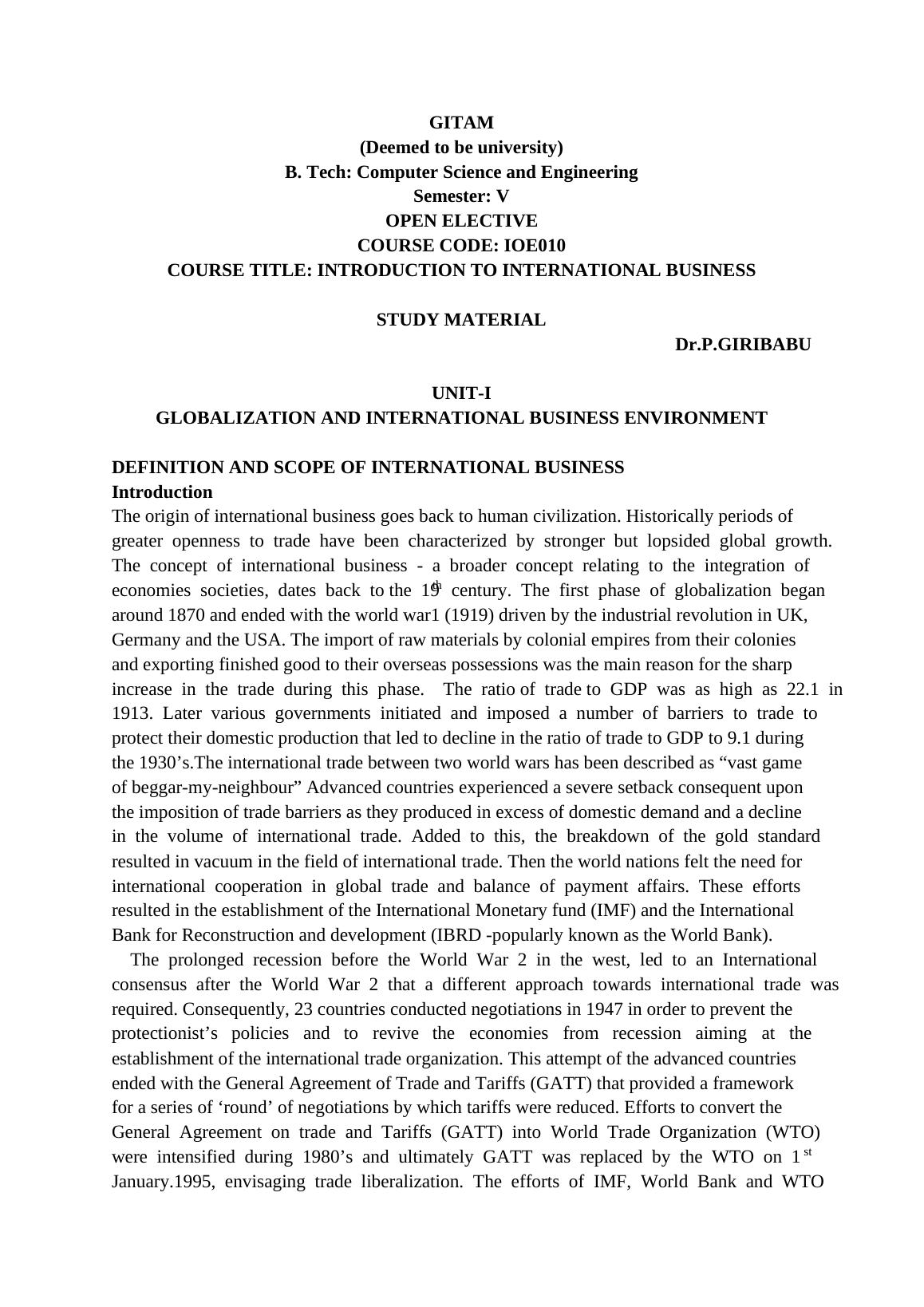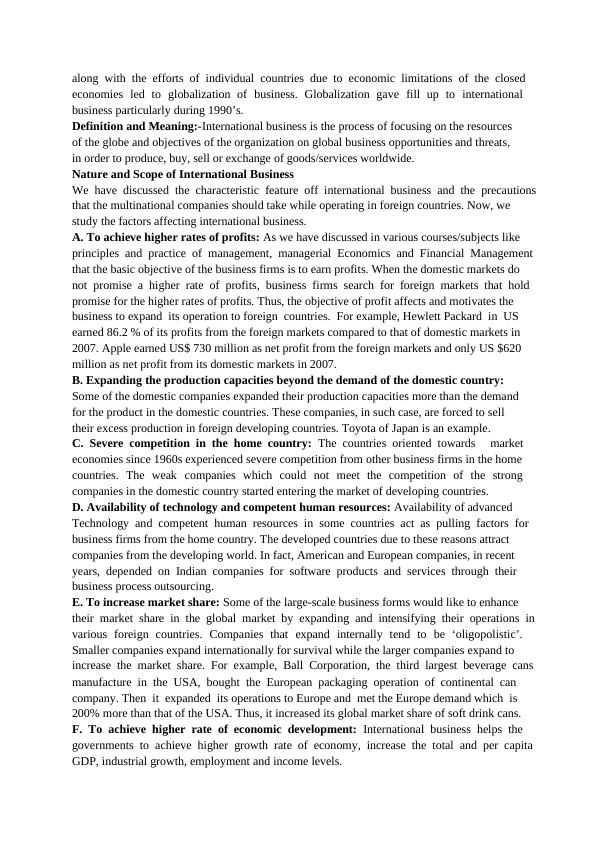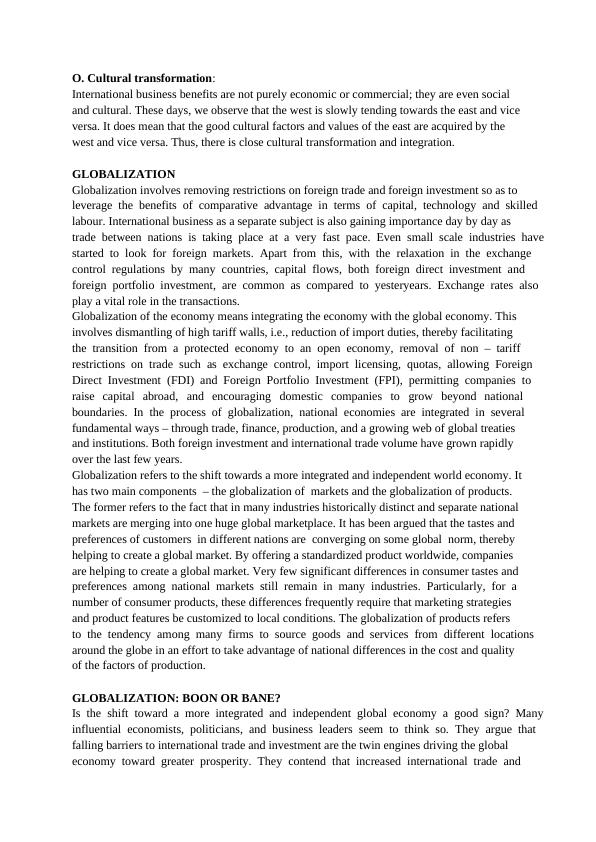Introduction to International Business PDF
Added on 2020-10-06
19 Pages10174 Words167 Views
GITAM (Deemed to be university) B. Tech: Computer Science and Engineering Semester: V OPEN ELECTIVE COURSE CODE: IOE010 COURSE TITLE: INTRODUCTION TO INTERNATIONAL BUSINESS STUDY MATERIAL Dr.P.GIRIBABU UNIT-IGLOBALIZATION AND INTERNATIONAL BUSINESS ENVIRONMENT DEFINITION AND SCOPE OF INTERNATIONAL BUSINESS Introduction The origin of international business goes back to human civilization. Historically periods of greater openness to trade have been characterized by stronger but lopsided global growth. The concept of international business - a broader concept relating to the integration of economies societies, dates back to the 19thcentury. The first phase of globalization began around 1870 and ended with the world war1 (1919) driven by the industrial revolution in UK, Germany and the USA. The import of raw materials by colonial empires from their colonies and exporting finished good to their overseas possessions was the main reason for the sharp increase in the trade during this phase. The ratio of trade to GDP was as high as 22.1 in 1913. Later various governments initiated and imposed a number of barriers to trade to protect their domestic production that led to decline in the ratio of trade to GDP to 9.1 during the 1930’s.The international trade between two world wars has been described as “vast game of beggar-my-neighbour” Advanced countries experienced a severe setback consequent upon the imposition of trade barriers as they produced in excess of domestic demand and a decline in the volume of international trade. Added to this, the breakdown of the gold standard resulted in vacuum in the field of international trade. Then the world nations felt the need for international cooperation in global trade and balance of payment affairs. These efforts resulted in the establishment of the International Monetary fund (IMF) and the International Bank for Reconstruction and development (IBRD -popularly known as the World Bank). The prolonged recession before the World War 2 in the west, led to an International consensus after the World War 2 that a different approach towards international trade was required. Consequently, 23 countries conducted negotiations in 1947 in order to prevent the protectionist’s policies and to revive the economies from recession aiming at the establishment of the international trade organization. This attempt of the advanced countries ended with the General Agreement of Trade and Tariffs (GATT) that provided a framework for a series of ‘round’ of negotiations by which tariffs were reduced. Efforts to convert the General Agreement on trade and Tariffs (GATT) into World Trade Organization (WTO) were intensified during 1980’s and ultimately GATT was replaced by the WTO on 1stJanuary.1995, envisaging trade liberalization. The efforts of IMF, World Bank and WTO

along with the efforts of individual countries due to economic limitations of the closed economies led to globalization of business. Globalization gave fill up to international business particularly during 1990’s. Definition and Meaning:-International business is the process of focusing on the resources of the globe and objectives of the organization on global business opportunities and threats, in order to produce, buy, sell or exchange of goods/services worldwide. Nature and Scope of International Business We have discussed the characteristic feature off international business and the precautions that the multinational companies should take while operating in foreign countries. Now, we study the factors affecting international business. A. To achieve higher rates of profits: As we have discussed in various courses/subjects like principles and practice of management, managerial Economics and Financial Management that the basic objective of the business firms is to earn profits. When the domestic markets do not promise a higher rate of profits, business firms search for foreign markets that hold promise for the higher rates of profits. Thus, the objective of profit affects and motivates the business to expand its operation to foreign countries. For example, Hewlett Packard in US earned 86.2 % of its profits from the foreign markets compared to that of domestic markets in 2007. Apple earned US$ 730 million as net profit from the foreign markets and only US $620 million as net profit from its domestic markets in 2007. B. Expanding the production capacities beyond the demand of the domestic country: Some of the domestic companies expanded their production capacities more than the demand for the product in the domestic countries. These companies, in such case, are forced to sell their excess production in foreign developing countries. Toyota of Japan is an example. C. Severe competition in the home country: The countries oriented towards market economies since 1960s experienced severe competition from other business firms in the home countries. The weak companies which could not meet the competition of the strong companies in the domestic country started entering the market of developing countries. D. Availability of technology and competent human resources: Availability of advanced Technology and competent human resources in some countries act as pulling factors for business firms from the home country. The developed countries due to these reasons attract companies from the developing world. In fact, American and European companies, in recent years, depended on Indian companies for software products and services through their business process outsourcing. E. To increase market share: Some of the large-scale business forms would like to enhance their market share in the global market by expanding and intensifying their operations in various foreign countries. Companies that expand internally tend to be ‘oligopolistic’. Smaller companies expand internationally for survival while the larger companies expand to increase the market share. For example, Ball Corporation, the third largest beverage cans manufacture in the USA, bought the European packaging operation of continental can company. Then it expanded its operations to Europe and met the Europe demand which is 200% more than that of the USA. Thus, it increased its global market share of soft drink cans. F. To achieve higher rate of economic development: International business helps the governments to achieve higher growth rate of economy, increase the total and per capita GDP, industrial growth, employment and income levels.

G. Tariffs and import Quotas: It is quite common before the globalization that the governments imposed tariffs or duty on imports to protect the domestic company. Sometimes government also fixes import quotas in order to reduce the competition to the domestic companies from the competent foreign companies. These practices are prevalent not only in developing countries but also in advanced countries. H. High living standards: Comparative cost theory indicates that the companies which have the advantage of raw materials , human resources , natural resources and climatic conditions in producing particular goods can produce the products at low cost and also of high quality. Customers in various countries can buy more products with same amount of money. In turn, it can also enhance the living standards of the people through enhanced purchasing power and by consuming high quality products. I. Increased socio-economic Welfare: International business enhances consumption level, and economic welfare of the people of the trading countries. For example, the people of China are now enjoying a variety of products of various countries than before as China has been actively involved in international business like Coca-Cola, McDonald’s range of products, electronic products of Japan and coffee from Brazil. Thus, the Chinese consumption levels and socio-economic welfare are enhanced. J. Wider Market: International business widens the market and increases the market size. Therefore, the companies need not depend on the demand for the products in a single country or customer’s tastes and preferences of a single country. Due to that enhanced market the Air France, now, mostly depends on the demand for air travel of the customers from countries other than France. This is true in case of most of the MNCs like Toyota, Honda, Xerox and Coca-Cola. K. Large-scale economies: multinational companies due to the wider and larger markets produce large quantities, which provide the benefit of large scale economies like reduced cost of the production, availability of expertise, quality etc. L. Provides the opportunity For and challenge to domestic business: International business firms provides the opportunities to the domestic companies. These opportunities include technology, management expertise, market intelligence, product developments etc. For example, Japanese firms operating in the US provide these opportunities to the US companies. This is more evident in the case of the developing countries like India, African countries and Asian countries. M. Economic growth of the world: Specialization, division of labour, enhancement of productivity, posing challenges, development to meet them, innovations and creations to meet the competition lead to overall economic growth of the world nations. International business particularly helped the Asian countries Like Japan, Taiwan, Korea, Philippines, Singapore, Malaysia, and the United Arab emirates. N .Optimum and proper utilization of world resources: International business provides for the flow of raw materials, natural resources and human resources from the countries where they are in excess supply to those countries which are in short supply or need most. For example, flow of human resources from India, consumer goods from UK, France, Italy and Germany to developing countries. This, in turn, helps in the optimum and proper utilization of world resources.

O. Cultural transformation: International business benefits are not purely economic or commercial; they are even social and cultural. These days, we observe that the west is slowly tending towards the east and vice versa. It does mean that the good cultural factors and values of the east are acquired by the west and vice versa. Thus, there is close cultural transformation and integration. GLOBALIZATION Globalization involves removing restrictions on foreign trade and foreign investment so as to leverage the benefits of comparative advantage in terms of capital, technology and skilled labour. International business as a separate subject is also gaining importance day by day as trade between nations is taking place at a very fast pace. Even small scale industries have started to look for foreign markets. Apart from this, with the relaxation in the exchange control regulations by many countries, capital flows, both foreign direct investment and foreign portfolio investment, are common as compared to yesteryears. Exchange rates also play a vital role in the transactions. Globalization of the economy means integrating the economy with the global economy. This involves dismantling of high tariff walls, i.e., reduction of import duties, thereby facilitating the transition from a protected economy to an open economy, removal of non – tariff restrictions on trade such as exchange control, import licensing, quotas, allowing Foreign Direct Investment (FDI) and Foreign Portfolio Investment (FPI), permitting companies to raise capital abroad, and encouraging domestic companies to grow beyond national boundaries. In the process of globalization, national economies are integrated in several fundamental ways – through trade, finance, production, and a growing web of global treaties and institutions. Both foreign investment and international trade volume have grown rapidly over the last few years. Globalization refers to the shift towards a more integrated and independent world economy. It has two main components – the globalization of markets and the globalization of products. The former refers to the fact that in many industries historically distinct and separate national markets are merging into one huge global marketplace. It has been argued that the tastes and preferences of customers in different nations are converging on some global norm, thereby helping to create a global market. By offering a standardized product worldwide, companies are helping to create a global market. Very few significant differences in consumer tastes and preferences among national markets still remain in many industries. Particularly, for a number of consumer products, these differences frequently require that marketing strategies and product features be customized to local conditions. The globalization of products refers to the tendency among many firms to source goods and services from different locations around the globe in an effort to take advantage of national differences in the cost and quality of the factors of production. GLOBALIZATION: BOON OR BANE? Is the shift toward a more integrated and independent global economy a good sign? Many influential economists, politicians, and business leaders seem to think so. They argue that falling barriers to international trade and investment are the twin engines driving the global economy toward greater prosperity. They contend that increased international trade and

End of preview
Want to access all the pages? Upload your documents or become a member.
Related Documents
Changing nature of New Zealand international trade agreements Topic 2022lg...
|14
|1241
|14
International Commercial Lawlg...
|16
|3735
|480
Trade War Between USA and China Topic 2022lg...
|9
|523
|9
International Trade Law and Arbitration: Understanding the World Trade Organization and Alternative Dispute Resolutionlg...
|13
|3804
|414
World Trade Organization: A Review of Negotiations and Objectiveslg...
|8
|1470
|262
WTO Negotiations with Serbia and Kazakhstan: Reasons for Delay in Membershiplg...
|13
|3180
|379
